#Molecular Biology and Evolution
Text

"Evolution is a fact, not a theory. It really happened, and the fossil record and the molecular biology all confirm it. And yet, in this country, the United States, which is the leading scientific country in the world, we have people who are not only ignorant of science, but who are actively hostile to it and to the scientific method. And that is a serious problem, because science is not just a body of knowledge, it's a way of thinking. It's a way o skeptically interrogating the universe with a fine undersanding of human fallibility."
-- Carl Sagan
#Carl Sagan#evolution#theory of evolution#evolution is a fact#science#human fallibility#scientific method#what science is#fossil record#molecular biology#evolution deniers#evolution denial#religion is a mental illness
505 notes
·
View notes
Text
How was complex life able to develop on the inhospitable early Earth? At the beginning there must have been ribonucleic acid (RNA) to carry the first genetic information. To build up complexity in their sequences, these biomolecules need to release water. On the early Earth, which was largely covered in seawater, that was not so easy to do.
In a paper published in the Journal of the American Chemical Society (JACS), researchers from the team of LMU professor Dieter Braun have shown that in RNA's struggle with the surrounding water, its natural recycling capabilities and the right ambient conditions could have been decisive.
Continue Reading.
70 notes
·
View notes
Text
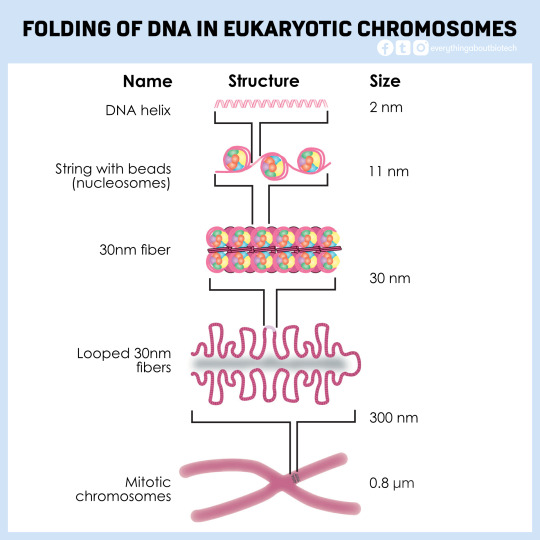
Folding of DNA in Eukaryotic Chromosome
#biotechnology#biotech#science#biology#biochemistry#studyblr#molecularbiology#students#bioinformatics#molecular biology#biotechnology science#school#scicomm#sciart#scientists#women in science#sciencenotes#geology#stem#evolution#dna discovery#dna test#genome#genomics#cell biology#molecules#molecule
124 notes
·
View notes
Text
Okay I’m finally excited abt term starting now this is gonna be GOOD
#it might just be that I just watched queer eye. who knows#but I’m like. actually sorting out a pretty significant amount of the things all in one go bc this is how I do things apparently#saltatory evolution. anyway#I’m gonna go back to uni and see my FRIENDS#I’m doing a bunch of stuff in freshers week bc I’m running a stall in freshers fair and then there’s ice hockey which is gonna be insane#at the start of the year it’s SO busy and I gotta run it and it’s gonna be stressful as hell but so fun#even the times when it’s super busy and I have to do things more than play it’s good it’s a rlly nice atmosphere#and I made plans to go skating with some of my friends after we finish setting up the stall on the Tuesday#and I’m getting a bunch of stuff for my room!! I have a rug and I’m finally getting a sun lamp#and stealing some photos and I’m gonna get some nice ones printed. definitely buying another poster#and I WILL make the kitchen nice this year if it kills me I wanna have people over and actually eat there sometimes#and I’m getting some new clothes!! and I’m gonna get some when I’m back at uni so it’s lower pressure#oh and I actually realised that even though it’s Hard I kinda like the molecular biology module I’m doing#I think it should be manageable if I keep up with it and I have all the things set out to do that#AND a free enough timetable that I’ll be able to keep up with it with a little effort#I’m gonna get a planner or something I think bc they’re fun to write in and it’ll be nice to have everything in one place#OH OH AND IVE MADE PLANS TO COOK WITH MY OTHER FRIEND WHO LIVES LIKE FIVE DOORS DOWN#which is gonna be SO nice#I’m gonna tell my goddamn flatmate to keep his shit off the kitchen table#and I’m living with people I actually like now#with a bunch of my other friends next door#and one of my best friends will actually have free time this year!!!! she had none last year we’re actually gonna be able to do things#this is gonna be a good year I’ve decided I don’t care I will MAKE this year a good year#it’s gonna be a good year.#luke.txt
3 notes
·
View notes
Photo

Tome Sweet Tome
The surfaces of all cells in nature are festooned with a complex and diverse array of sugar chains (called glycans). These perform a wide variety of biological functions, from the proper folding of proteins to cell-to-cell interactions. Their ubiquity in nature underscores their essentialness to complex life.
This week, the fourth edition of “Essentials of Glycobiology” (the study of glycans) was published by Cold Spring Harbor Laboratory Press. It’s a continuation and updating of landmark work by a consortium of editors, led by Ajit Varki, MD, Distinguished Professor in the departments of Medicine and Cellular and Molecular Medicine at UC San Diego School of Medicine, with contributions from a number of UC San Diego scientists and physicians, including Jeffrey D. Esko, PhD, Distinguished Professor of cellular and molecular medicine; Pascal Gagneux, PhD, professor of pathology and anthropology, and Kamil Godula, PhD, associate professor of chemistry and biochemistry, and Amanda Lewis PhD, professor of obstetrics-gynecology and reproductive science.
Varki and Esko are also founding directors of the Glycobiology Research and Training Center (GRTC) at UC San Diego, established in 1999, and have recently handed over leadership to Lewis and Godula.
Glycobiology is a relatively new scientific discipline. The term was only coined in 1988, recognizing the combining of carbohydrate chemistry and biochemistry to focus on glycans, which have since proven to have a multitude of diverse and often critical roles in biology.
They have been linked to human origins and as a key evolutionary marker. They are found to both inhibit and promote tumor growth; and the presence of a particular sialic acid in red meat may be linked to increased cancer risk in humans. Another class of glycans called glycosaminoglycans have been shown by Esko and colleagues to be involved in COVID-19 coronavirus pathogenesis. The cover of the fourth edition presents an all-atom model of infamous spike protein of the pandemic virus, emphasizing the massive array of glycan chains modelled by UC San Diego professor of biology Rommie Amaro.
Varki, Esko and colleagues at the GRTC have been central to many of the advances in glycobiology, and the textbook, which originally debuted in 1999, has been an enduring effort to broadly introduce and describe the rapidly changing discipline.
For example, the second edition of “Essentials of Glycobiology,” published in 2008, appeared simultaneously in print from the Cold Spring Harbor Laboratory Press, and free online to reach a wider audience. Subsequent editions have also been free online at the National Center for Biotechnology Information at the National Library of Medicine.
“This approach ensures that everyone, from the layperson to the high school student to the graduate student in a developing country, has free access to the knowledge the book contains, while increasing awareness of the availability of a printed edition that may be more suitable for some readers’ requirements,” said Varki at the time.
— Scott LaFee
Pictured above: In this electron micrograph, the surface of a bacterium is fuzzy with a coating of glycans.
#science#medicine#glycobiology#glyans#coronavirus#spike protien#human evolution#cancer#cellular and molecular medicine#pathology#cell biology#molecular biology#academic medicine#chemistry#biochem#uc san diego#ucsd
41 notes
·
View notes
Text
Basically fish are real and expiration dates are fake but the way fish are real (linguistics) is different than the way expiration dates are fake (legalese)
That seems to be the summary of my tumblr rants today but the day's not over yet so we'll see ;)
#also i am for real a professional biologist#and not just a biologist but my degree was specifically about cellular developmental and molecular biology#so we talked about evolution and biological chemicals all fucking day
2 notes
·
View notes
Text
youtube
#molecular biology#biology#origins of life#dark vitalism#Youtube#cellular#living cells#evolutionary biology#evolution#Abiogenesis
0 notes
Text
Chapters of Life - Evolution: From Chemistry to Complexity
Chapter 1: The Primordial Soup – Where It All Began
Once upon a time, about 3.8 billion years ago, the Earth was a very different place. Volcanoes roared, oceans boiled, and the atmosphere was a cocktail of gases. In this seemingly inhospitable environment, a miraculous event occurred – the birth of life from non-life, a process known as abiogenesis.
Picture a warm, shallow pool or a deep-sea…
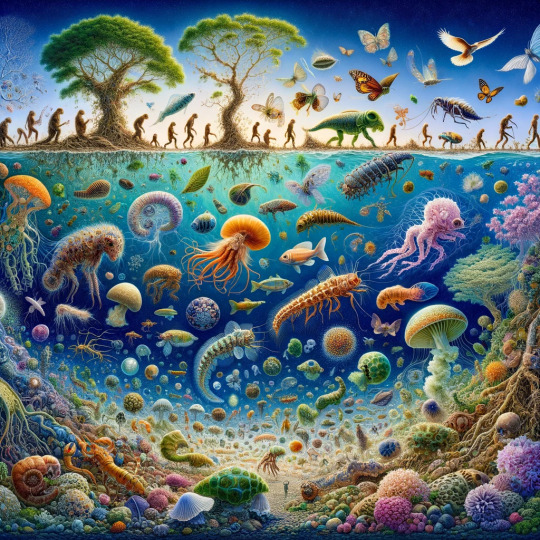
View On WordPress
#abiogenesis#amino acids#biological evolution#cellular specialization#DNA double helix#Earth&039;s ecosystems#endosymbiotic theory#eukaryotic cell evolution#evolution of life#first cells#genetic blueprint#life&039;s diversity#lipid bubbles#molecular biology#multicellular organisms#nucleotides#origin of life#primordial Earth#RNA world hypothesis
0 notes
Text
During hovering, hummingbirds flap their wings up to 80 times per second, creating the characteristic humming sound. No other form of locomotion in the animal kingdom consumes more energy. Accordingly, their metabolism runs at full speed and is more active than that of any other vertebrate.
Hummingbirds, native to North and South America. They have unique metabolism genes and have a diet of sugar.
The Scientists discovered that the gene encoding the muscle enzyme FBP2 AKA fructose bisphosphatase 2 was lost in all studied hummingbirds. The gene was lost in the common ancestor of all living hummingbirds from 48 to 30 million years ago.
Inactivation of the FBP2 gene in muscle cells enhances sugar metabolism. Furthermore, the number and activity of the energy-producing mitochondria increases in cells lacking FBP2. All this has already been observed in the flight muscles of hummingbirds.
Loss of a gluconeogenic muscle enzyme contributed to adaptive metabolic traits in hummingbirds
SCIENCE 12 Jan 2023 Volume 379, Issue 6628 pp. 185-190
0 notes
Text
Have you heard about mole genders?

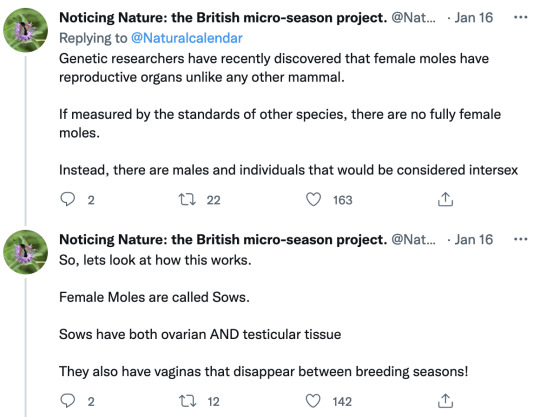




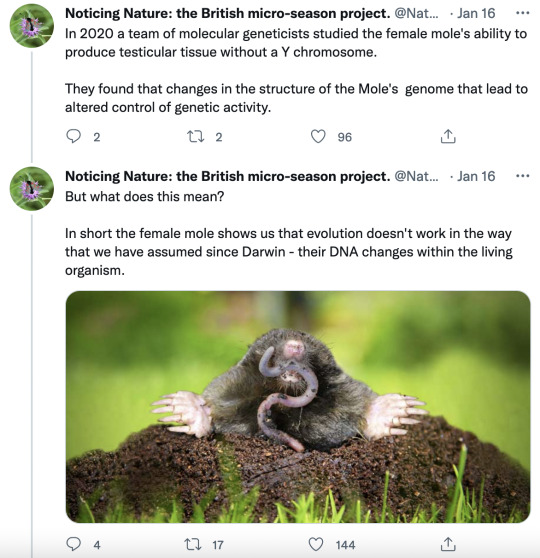
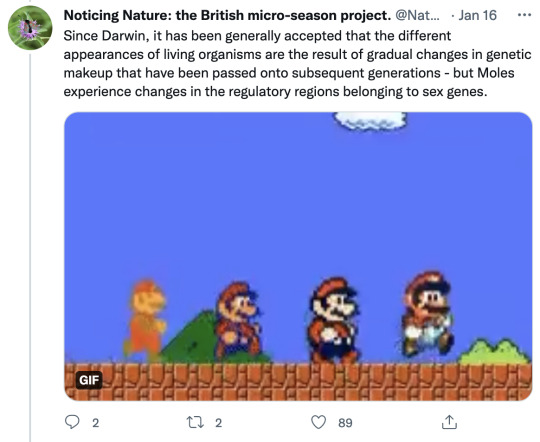
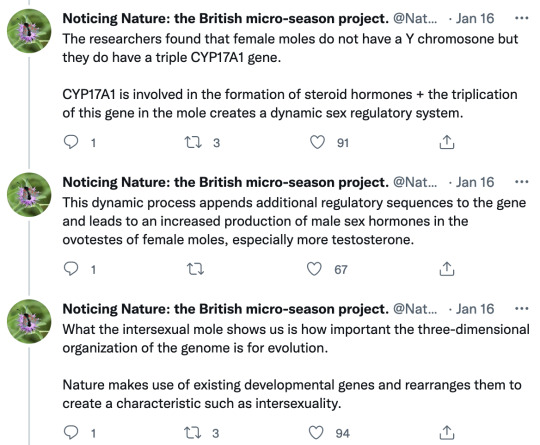

I’ve heard of this concept in sci-fi, but thought it was absolutely made up. I know some fish and frogs can change genders, but not in cycles like this. Wild. If I slapped this down in some alien world without explanation, I’d laugh in my own face. But no, real biology IS that bizarre.
Image descriptions:
A series of tweets from @NaturalCalendar that say:
Hello lovely Nature Noticers. It is time for today's thread! Follow me, and we'll delve deep into the subterranean and subversive world of Talpa europaea, the common European mole. We'll begin with a bombshell - there are no female moles.
Genetic researchers have recently discovered that female moles have reproductive organs unlike any other mammal. If measured by the standards of other species, there are no fully female moles. Instead, there are males and individuals that would be considered intersex.
So, lets look at how this works. Female Moles are called Sows. Sows have both ovarian AND testicular tissue They also have vaginas that disappear between breeding seasons!
Most of the year, female moles look and behave like males. They have masculinised genitals, with no external vagina + an enlarged clitoris. When this point in the year arrives, mating season begins. At this point the Sow's testosterone levels drop + they develop a vagina.
As is typical for mammals, Sows are equipped with two X chromosomes and Boars with an X and a Y chromosome. Unlike any other mammals Sows simultaneously develop functional ovarian and testicular tissues united in one organ, the 'ovotestis'. This is unique to Moles.
This testicular tissue does not produce sperm. It does however, produce large amounts of the sex hormone testosterone, meaning that Sows have similar testosterone levels to the Boars -except during mating season.
Scientists have hypothesized that these high levels of testosterone provide an adaptive advantage for the mole's underground life - providing added muscle mass for Sows who need to dig burrows and fight for resources for their offspring.
This is a dynamic process - the ovarian tissue that makes eggs and gets larger during breeding, then regresses. Outside of breeding season the testicular tissue, expands until it’s larger than the ovarian end - flooding the Sow's system with testosterone.
This explains why female moles have male-like genitalia... But it doesn't explain how patch of testicular tissue forms in female moles even though they do not have a Y chromosome. Up until recently the Y chromosome was thought to be fundamental to male sex determination.
In 2020 a team of molecular geneticists studied the female mole's ability to produce testicular tissue without a Y chromosome. They found that changes in the structure of the Mole's genome that lead to altered control of genetic activity.
But what does this mean? In short the female mole shows us that evolution doesn't work in the way that we have assumed since Darwin - their DNA changes within the living organism.
Since Darwin, it has been generally accepted that the different appearances of living organisms are the result of gradual changes in genetic makeup that have been passed onto subsequent generations - but Moles experience changes in the regulatory regions belonging to sex genes.
The researchers found that female moles do not have a Y chromosone but they do have a triple CYP17A1 gene. CYP17A1 is involved in the formation of steroid hormones + the triplication of this gene in the mole creates a dynamic sex regulatory system.
This dynamic process appends additional regulatory sequences to the gene and leads to an increased production of male sex hormones in the ovotestes of female moles, especially more testosterone.
What the intersexual mole shows us is how important the three-dimensional organization of the genome is for evolution. Nature makes use of existing developmental genes and rearranges them to create a characteristic such as intersexuality.
We see in the mole that evolution is not a linear process, arranged around the principle of Euclidian geometry. It is rather a topological process - a structure cast in rubber that is responsive and adaptive to the environment.
The mole also reminds us of the complexity of sexual development. The shifting sexual characteristics of the mole shows how the process of sexual development can, and does result in a wide range of natural variations.
#biology#gender#moles#fun animal facts#intersex#truth is stranger than fiction#yes I’ve read The Left Hand of Darkness#I’ve seen this idea elsewhere too#I had no idea it was based on something so exact#bonkers man#trans#mole genders
38K notes
·
View notes
Text
🕷️Meet Joe Arguelles, a comparative biology Ph.D. student in the Museum’s Richard Gilder Graduate School. His research focuses on understanding the molecular drivers of the incredible mechanical properties of spider silks.
🕸️He also studies the evolution of “prey capture systems” (silk, venom, and vision) in active hunting spiders, and how these genes have changed in response to the loss of web-spinning behavior.
#spiders#silk#spider silk#stem#halloween#research#museums#did you know#fact of the day#amnh#cool facts#arachnids#arachnology#phd#science#nature#natural history
2K notes
·
View notes
Text
1 note
·
View note
Text
building on that best science poll bc biology is far in the lead !! also feel free to go into specifics in the tags since i had to choose a broad 10 options 🤧
426 notes
·
View notes
Text
Researchers reporting in the journal Current Biology on December 4 have found the earliest-known fossil mosquito in Lower Cretaceous amber from Lebanon. What's more, the well-preserved insects are two males of the same species with piercing mouthparts, suggesting they likely sucked blood. That's noteworthy because, among modern-day mosquitoes, only females are hematophagous, meaning that they use piercing mouthparts to feed on the blood of people and other animals.
"Lebanese amber is, to date, the oldest amber with intensive biological inclusions, and it is a very important material as its formation is contemporaneous with the appearance and beginning of radiation of flowering plants, with all what follows of co-evolution between pollinators and flowering plants," says Dany Azar of the Nanjing Institute of Geology and Paleontology at the Chinese Academy of Sciences and the Lebanese University.
"Molecular dating suggested that the family Culicidae arose during the Jurassic, but previously the oldest record was mid-Cretaceous," says André Nel of the National Museum of Natural History of Paris (Muséum National d'Histoire Naturelle de Paris). "Here we have one from the early Cretaceous, about 30 million years before."
The Culicidae family of arthropods includes more than 3,000 species of mosquitoes. The new findings suggest that male mosquitoes in the past fed on blood as well, according to the researchers. They also help to narrow the "ghost-lineage gap" for mosquitoes, they say.
Continue Reading.
184 notes
·
View notes
Note
Hi Dr Scherz, what were your favourite subjects back when you were studying undergraduate zoology? 🍀
Totally different than what I expected! I thought the core zoology courses would be my favourites, but in the end, I think my favourite courses were Molecular Phylogenetics, Evolutionary and Ecological Genetics, Evolution of Sex and Breeding Systems, Evolution of Parental Care, Developmental Biology, and Parasite Biology. I can attribute 80% of my enjoyment of those courses to the fantastic lecturers that we had at the University of Edinburgh, who conveyed both deep knowledge of and enthusiasm for the subject matter.
My least favourite courses were also the courses I fared worst in, i.e. Medical Biology, Principles of Ecology, and Population and Community Ecology. Surprise surprise, I am no ecologist. I should by rights also probably have failed Biological Chemistry in my first year, but somehow I scraped by with a tolerable mark.
#undergraduate#zoology#animals#biology#university#undergrad#University of Edinburgh#BSc#about me#answers by Mark#tzatziki-boy
99 notes
·
View notes
Text
here's one that's even more bonkers that I didn't report on. it involves writers over at Haaretz being very incompetent.
on the age of chickpea cultivation in Palestine, people variously say 10,000 BC, 8400 BC, 8000 BC, 7000 BC &c. as if at random.
foodtimeline.org (which supposedly provides sources to the researcher but has betrayed me many, many times) cites: Food in the Ancient World From A to Z, Andrew Dalby [Routledge: London] 2003 (p. 84).
Dalby says:
Chickpea, one of the oldest cultivated pulses in the Near East. Chickpeas were grown in Palestine by 8000 BC.
this book is actually useless from a research perspective and belongs to what I like to call the "just some guy saying something" approach to making claims. none of the works cited at the end of the page on chickpeas (yes! none of the claims are associated with a particular work! there are no footnotes! so if you want to trace a particular claim, you've gotta look in each work mentioned! lol!) are scholarly works either, all of them also belong to the "some guy saying something" school of thought, and, most dizzyingly, none of them contain the 8000 BC claim!
okay, let's take another tack. wikipedia says:
"The earliest well-preserved archaeobotanical evidence of chickpea outside its wild progenitor's natural distribution area comes from the site of Tell el-Kerkh, in modern Syria, dating back to the early Pre-Pottery Neolithic period around (c.8400BCE). [12]"
[12] turns out to be an article titled "The Strange Origin Story of the Chickpea" on Haaretz (ugh), which is hardly a scholarly source, but perhaps it cites one! Haaretz says:
The question addressed in a new paper published in May in the journal of Molecular Biology and Evolution is historic: how the domestic chickpea arose and spread, first apparently to the Middle East – signs of chickpea domestication were identified in el-Kerkh, Syria, that may be as old as the 10th millennium B.C.E. – and onwards, the western Mediterranean and to Asia, and to eastern Africa (specifically, Ethiopia).
the particularly sharp-eyed among you may notice that "10th millennium BC" (10,000 to 9,001 BC) is a different claim from "8400 BC," but, oh well, let's click that link.
it's a paper titled "Historical Routes for Diversification of Domesticated Chickpea Inferred from Landrace Genomics." it contains no references to the finds in el-Kerkh, or to a 10th millennium BC claim, or a 9th century BC (which the year 8400 belongs to) claim; it's more about developing a model to trace spread, rather than attesting evidence for any particular date. the author of this article must have just added the information about the site in Syria from, idk, their own background knowledge? lol.
but let's keep pushing this. elsewhere in the same article, a paper titled "Draft genome sequence of Cicer reticulatum L., the wild progenitor of chickpea provides a resource for agronomic trait improvement" is linked. this paper contains in its introduction the claim:
Chickpea was domesticated with wheat, barley, peas and lentil as a member of West Asian Neolithic crops during the origin of agriculture around 10,000 years ago with the oldest archaeological evidence from 7500 B.C.4,5
also a very different claim from both "8400" and "10th millennium BC", but okay, let's try to trace this one.
citation 4 is a paper titled "Evolution of cultivated chickpea: four bottlenecks limit diversity and constrain adaptation," and it also has to do with something completely different from archaeological evidence for chickpea cultivation. in reference to the claim it is cited to support, it contains only the sentence:
Chickpea is [...] associated with the origin of agriculture in the Fertile Crescent some 10000 years ago.
for this rather vague claim, they themselves cite two other sources: 2000, Lev-Yadun et al. "The cradle of agriculture," Science 288, 1602-1603; and 1999, Zohary D, Hoph M "Monophyletic vs. polyphyletic origin of the crops on which agriculture was founded in the Near East," Genetic Resources and Crop Evolution 46, 133-142.
citation 5 is Harlan J. R. 1971, "Agricultural origins: centers and noncenters," Science, 174, 468–474. this one says, summarizing other research, that in the "Near East" (bleucgh)
barley, einkorn, emmer, peas, lentils, flax, vetch, and chickpeas appear to have been domesticated, together with sheep, goats, pigs, and possibly cattle.
the source for this sentence is G. Wright and A. Gordus, Amler. J. Archaeol. 73, 75 (1969).
okay, well, this is starting to get obviously silly; trying to trace these claims further and further back until a primary report of an actual archaeology site is found is clearly pointless, especially since at this rate the find would be from like 1954 and almost certainly new evidence has come to light since then.
let's try something else. despite the fact that Haaretz's "signs of chickpea domestication were identified in el-Kerkh, Syria, that may be as old as the 10th millennium B.C.E" claim didn't actually come from the source that they cited, surely it must have come from somewhere?
I find two papers describing the finds in el-Kerkh, written by the same team. "The origins of cultivation of Cicer arietinum L. and Vicia faba L.: early finds from Tell el-Kerkh, north-west Syria, late 10th millennium B.P." is the one that deals specifically with the chickpea findings.
aha! here, perhaps, is the source of the "10th millennium BC" claim! I suspect someone misread the title of this article, and read nothing else!!
the trouble is twofold: 1. "10th millennium BP" is given as the age of the site, not specifically of the cultivated chickpeas that were found; and 2:
"BP" is not "BC"!!!
"BP" is a metric of time used in carbon dating. it means "before present." the "present" is set to the year 1950, since this is close to when carbon dating was introduced. 10,000 years before 1950 is 8050 BC, and this is the absolute oldest date allowable based on just the title of the paper.
however, if we actually read the paper (or, I mean, skim it for a date, lol), we finally find something concerned with dating a particular site rather than making a genetic model; still better, we find this beautiful, readily comprehensible table shewing us "Archaeobotanical records for C. arietinum [...] in the early Neolithic periods", citing a specific site, the number of beans found there, the estimated date BP of those beans based on carbon dating, and a reference to the paper that details each find:

the "this paper" reference based on the Tell el-Kerkh site gives the date
9350-9165 B.P.! that's 7400-7215 BC! we have a date range at last!
other papers in this chart give estimates that are more recent (e.g. 9320 - 9175 BP), based on papers from the 80s and 90s.
so, if this paper is more recent that any other citation I found during this whole journey (2006), and it claims to have pushed the date on the earliest piece of archaeological evidence for cultivation of the chickpea back (note that archaeological is different than evidence based on literature, genetics, &c.), then where on earth are "8000 BC" and "8400 BC" coming from? I still don't know.
tl;dr: a lot of people say that wikipedia, research blogs online, popular news publications, and things of that ilk are not sources on their own, but that they can be a good starting point to help you find sources. I no longer believe that to be the case. you are better off just starting in jstor or google scholar &c. and ignoring everything else. the claims you find in the latter way may, however, still be wild goose chases even if they are published in scholarly journals. the citation webs in academic journals are dizzying and people rarely trace a claim back to its actual origin, instead content to cite a source that cites a source that cites a source that cites a source........
anyway. I share my humble stories simply for entertainment purposes only.
49 notes
·
View notes